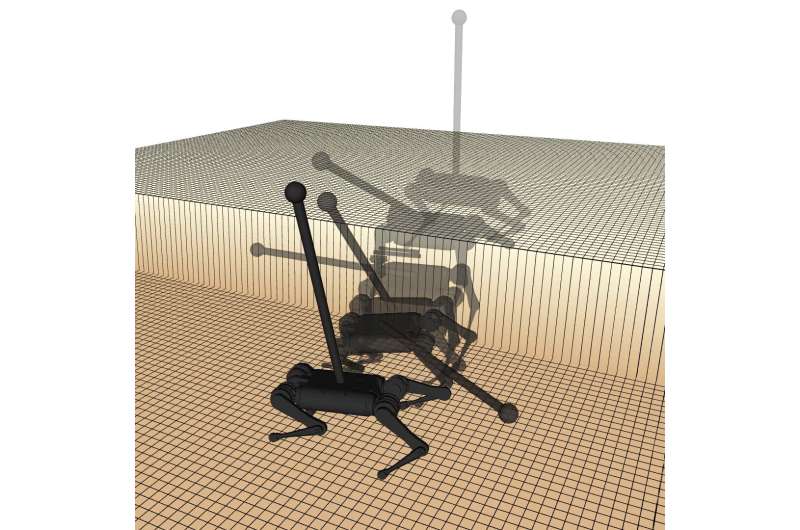Equipping Robots with Proprioception and a Tail Design

April 7, 2023 feature
This article has been reviewed according to Science X's editorial process and policies. Editors have highlighted the following attributes while ensuring the content's credibility:
- fact-checked
- preprint
- trusted source
- proofread
by Ingrid Fadelli , Tech Xplore
Researchers at Carnegie Mellon University (CMU)'s Robomechanics Lab have introduced two new approaches that could enhance the mobility of legged robots on rocky or extreme terrains. These approaches, outlined in a pre-published paper on arXiv, are inspired by the innate proprioception abilities and tail mechanics of animals.
'Our paper aims to bring legged robots from the ideal lab environments into real-world environments, where they may encounter challenging terrains such as rocky hills and curbs,' said Yanhao Yang, one of the researchers who conducted the study, to Tech Xplore. 'To achieve this, we drew inspiration from both animals and engineering principles.'
Cats and other felines are among many animals known to walk along their own footprints, allowing them to ground themselves and maintain their stability on different terrains. Yang and his colleagues attempted to replicate this behavior in robots by merging proprioception and motion planning techniques.
The use of these techniques enables robots to 'sense' their environment and move more reliably by gathering information about their own body's position, actions, and location. This capacity, known as 'proprioception,' overcomes the limitations of computer vision systems, which are adversely impacted by sensor noise, obstacles in the environment, light reflections on nearby objects, and poor lighting conditions.
Most existing robots rely on vision systems, which use cameras, lidar technology, and other external sensors to make sense of their surroundings. Unlike these vision systems, Yang and his colleagues propose the use of data collected by sensors integrated inside the robot, such as motors, encoders, and inertial measurement devices.
'This helps the robot detect when it slips or falls and adjust its movements to avoid tipping over,' explained Yang. 'The main advantage of this system is that it's more robust to environmental noise, like obstacles, reflections, or lighting conditions. The challenge is to make correct control and planning decisions under uncertainty when the proprioception senses an accident.'
In addition to their proposed proprioception system, the researchers devised a computational model that enables robots to control an artificial tail, similar to how animals move their tails when navigating environments. Squirrels and cats are among the many animals that use their tails to maintain balance when jumping or hopping onto surfaces.
'We noticed that animals use their tails to assist their agile locomotion, but most robots do not have tails,' Yang explained. 'For example, cheetahs use their tails to achieve rapid acceleration, deceleration, and quick turns, while squirrels use their furry tails to balance when jumping between branches. We adapted this idea by adding a tail to our quadruped robots, which helps balance when the robot misses a foothold or falls off.'
Yang and his colleagues also created a control system that enables a legged robot's artificial tail to work in coordination with its legs, helping it maintain balance even when one or more of its legs lift from the ground. This technique can significantly enhance a robot's navigation in rough or uneven terrains, while also maximizing its efficiency in narrow or small spaces.
Yang and his colleagues evaluated their motion planning approaches in a series of simulations. The results are highly promising, as their bio-inspired proprioception and tail control methods allowed simulated legged robots to reduce unexpected slips and falls, while also improving their ability to reliably move in extreme and changing terrains.
These new motion planning techniques could be applied and tested on real legged robots, potentially enabling them to navigate challenging environments more reliably, reducing collisions and falls. This could make these robots better equipped to successfully complete search & rescue missions, environmental monitoring operations, and other real-world tasks that entail moving on uneven or challenging terrains.
'One of our main goals for future research is to test our proposed method on actual hardware,' Yang said. 'This will be a challenge because we need to accurately estimate the state and contact information, which are crucial for the proprioception and control of the robot.'
In their next works, Yang and his colleagues also plan to improve how their framework models and controls the tails of robots. This could further reduce collisions, including those between the tail and other parts of the robot's body or the environment.
'Another area of improvement is to extend the method to more complex terrains, such as narrow ravines or stepping stones,' Yang added. 'Currently, our approach assumes relatively simple terrain variations, but on more challenging terrains, the robot's legs may trip or hang. In these cases, our controller will still try to lower the robot's body to maintain stability, but we can further improve this by adding more events to the gait planning process.'
© 2023 Science X Network




